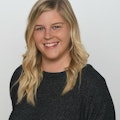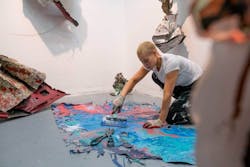While the maker movement is on the rise in cities all over the nation, it’s especially noticeable in one well-known borough – Brooklyn, New York. From furniture to mosaics to sculptures and home décor, Brooklyn has become quite the creative hub that continues to produce emerging design talent. Take Kennedy Yanko, for example. A painter-sculptor based in Bushwick, Brooklyn, Yanko works fluently in wood, metal, marble, and paint, repurposing natural materials in unexpectedly lyrical combinations. Her current work explores the limits of material gesture, and simultaneously reveals the innate links between seemingly dissimilar objects.
In our latest Maker Monday Q&A, learn a little more about Yanko and what drives her to design.
I got started at four-years-old. The very first painting I ever made was on the back of a Teenage Mutant Ninja Turtle cardboard box, and my parents framed it. To this day, it’s in my bedroom at home. All through childhood, I continued painting; I remember one day in seventh grade I came home from school, put some towels on the floor, pulled out two large pieces of paper, and quickly painted these big, abstract paintings. I remember feeling like something was coming through me, but also like I was being transported. I was in some kind of a trance while I was doing it, and afterward, I remember feeling so proud that I had made that, that I had done that, and I thought my work was really beautiful. That was the beginning. From there, I cultivated a studio practice out of my parent's basement, and have been growing since then.
What inspires you?
I’m really inspired by the abject, the derelict, and the things that are thrown away and discarded, especially within the realms of construction and architecture. I love bridges, trash, and industrial settings. When I was doing photography, I would do macro photographs of industrial junkyards and would be in awe of the textures, backgrounds, and foregrounds that would come across so elegantly in the frame.
What is your most memorable product or collection you’ve worked on and why?
WuWei (2009) was a really important collection for me because it was the first time I’d ever gone through the steps of building a show. It was the first time I was in a room with all of my work and was able to see that I had an ability to create in this way - to put together a collection. I was surprised that I understood what it meant to build a storyline, and how to weave a specific dialogue through each piece of work. That was a really important time for me because it was the beginning of me taking myself seriously as a professional artist.
Describe what a typical workday looks like for you.
I like to start my day around 9:30 a.m. with a little bit of exercise and meditation and [then] get into my studio around 11 a.m. I’ll usually come in and start by cleaning - it’s my way of figuring out what’s going on in my studio in that moment; it helps me see things. Then, I’ll typically pull out the materials that I’ve been thinking about or looking at, and in the midst of that I’ll start writing down what needs to happen for me that day, [including] what needs to happen in the studio, what I need from Home Depot, [and] what emails need to be addressed. I need to see my to-dos handwritten on paper. From there, I’ll spend the day going between sitting and looking at things, and then adjusting work where I need to. In the afternoon, I’ll often go do errands that I need to run for the studio, and then head over to the shop and do any metal work or welding that I need to do.
Name some must-haves you need or like to have on-hand when starting a new project.
I like to print out visual material when starting a project; it helps me to see and understand the overarching aesthetic of whatever’s about to happen. I’ll tack them up on a board along with samples of the materials I’m working with on that project, just to look at. I essentially build a storyboard.
Why Good Design is Always Authentic
What challenges you most during your creative process?
There’s an in-between moment that happens. There’s the initial point, where I’m storyboarding and figuring out the conceptual nature of a project, and then there’s the part where work starts to get built. But then, somewhere along the line, there’s a middle period where nothing happens and the only thing that makes a difference is time. I’m learning to make space within my brain and my heart to let whatever’s about to come out come through me when I hit this point, but it’s definitely been a challenge. So being patient in that middle, in that in-between when things are and are not happening is what I’m surrendering to. But as I get older, I’ve started to understand that that’s a moment of reprieve where I need to just stop and take a step back and maybe look at something else. The stillness, so to speak, is a gift.
What is your favorite thing in your working environment?
I love my big wooden table. It was left to me by an old roommate and it’s just this gorgeous eight-foot-long wooden table. I like to sit there. I eat lunch there. And when my studio manager comes in, that’s where we work and dream and ideate. When people come to the studio, it’s also where we’ll sit and visit. It’s something that’ll always be here, in my studio, for the rest of my life.
What is your favorite color?
Color is such an important thing for me. It’s at the center and beginning of everything that I do. It’s not really a matter of what my favorite color is; it’s more a matter of when you ask me that question. And in this moment, I’m really into these cool, kind of ugly tones; I have a lot of mustard yellow in my studio right now. I also have this nude, peachy blush--and I have seafoam green. It’s a very 70’s color palette in my studio right now.
Asbestos is back. Be prepared.
What is your favorite design era?
I’m actually strangely obsessed with Victorian interior designs right now. There’s an incredible exhibit at the Met of Victorian interiors, and while it’s not something that’s on my mind regularly, I’m constantly in awe of the opulence and the intricacies of all the work that was made during that time.
Who has helped you realize your dreams?
I’ve been so blessed and lucky to have incredible mentors in many different parts of my life and incredible people working around me and helping me to erect my dreams. I really can’t pinpoint one person. My studio manager, Julia, has been an incredible facilitator, allowing me to focus almost exclusively on my creative process. And I’ve also been surrounded by great artists like Hugo McCloud, Angel Otero, Mickalene Thomas, Derrick Adams, Rashid Johnson...these are artists who’ve encouraged me to follow my heart in the work that I’m making, and to listen to my intuition in my decision-making.
▼▼▼ Keep Scrolling. The article's not done!▼▼▼They’ve stood by my side in the last couple years and have encouraged me to share my work with, well, with everyone. Also, my parents. They’ve always just let me be me. I think their M.O. in parenting was just to let me figure out life on my own, because they knew I needed to. They’re still endlessly encouraging and supportive of me being an artist and proud of me for taking the path less traveled.
I would give students the advice to continue to surround themselves with people who are doing what they ultimately want to be doing, and to continue to refine their processes and themselves. No matter what, one is always going to have this particular style and taste, and it’s all a matter of evolving and refining that.
What’s next for you?
I’m leaving next week to do a residency with Galeria Leyendecker in the Canary Islands. I’ll be working on pieces for a solo show with them, opening September 7, 2018. Later in September, I’ll be exhibiting at EXPO Chicago with Kavi Gupta and Jenkins Johnson Gallery.
Where can people find your goods?
Jenkins Johnson Gallery. My website, kennedyyanko.com. My Instagram, @kennedyyanko.
Need more makers in your life? Dive into our full collection here.
About the Author

Adrian Schley
Associate Editor
Adrian Schley was an Associate Editor for i+s, where she covered the commercial interior design industry since 2018. Her work can also be found in BUILDINGS and Meetings Today.
